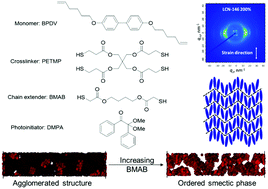Liquid crystalline networks based on photo-initiated thiol–ene click chemistry†
Abstract
Photo-initiated thiol–ene click chemistry is used to develop shape memory liquid crystalline networks (LCNs). A biphenyl-based di-vinyl monomer is synthesized and cured with a di-thiol chain extender and a tetra-thiol crosslinker using UV light. The effects of photo-initiator concentration and UV light intensity on the curing behavior and liquid crystalline (LC) properties of the LCNs are investigated. The chemical composition is found to significantly influence the microstructure and the related thermomechanical properties of the LCNs. The structure–property relationship is further explored using molecular dynamics simulations, revealing that the introduction of the chain extender promotes the formation of an ordered smectic LC phase instead of agglomerated structures. The concentration of the chain extender affects the liquid crystallinity of the LCNs, resulting in distinct thermomechanical and shape memory properties. This class of LCNs exhibits fast curing rates, high conversion levels, and tailorable liquid crystallinity, making it a promising material system for advanced manufacturing, where complex and highly ordered structures can be produced with fast reaction kinetics and low energy consumption.



 Please wait while we load your content...
Please wait while we load your content...